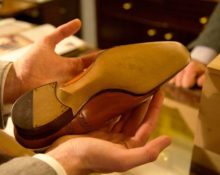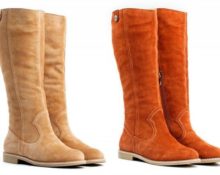Winter is a wonderful time of year. White snowdrifts are pleasing to the eye, snow-covered streets are transformed after the autumn slush. However, with the onset of the first frost, the paths and steps are covered with a layer of ice. Ice is a common phenomenon for everyone, but if you have slippery shoes, it becomes very dangerous to health and traumatic. And just normal movement causes difficulty. How to prevent shoes from slipping - read on for more details.
What can I do to prevent my boots from slipping?
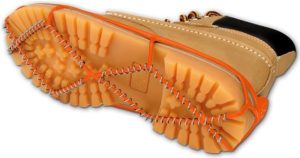 The most drastic decision is to buy new shoes. But who guarantees that they will not be as slippery as the previous ones? And you don’t want to spend significant amounts of money when you already have a pair of beautiful, comfortable boots on your feet.
The most drastic decision is to buy new shoes. But who guarantees that they will not be as slippery as the previous ones? And you don’t want to spend significant amounts of money when you already have a pair of beautiful, comfortable boots on your feet.
Also, specialized stores sell anti-slip stickers or rubber bands that stretch over the sole and prevent slipping. But they can’t always be easily found in a shopping center. Do not despair.Without special expenses, you can improve your shoes and make them anti-slip, either in a shoe workshop or on your own. Let's look at a few of the most popular methods.
Use cloth
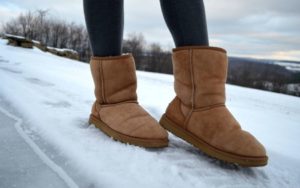 Some types of rough fabrics work well as anti-slip pads. Moreover, this folk method is considered one of the most durable and effective. It uses one of the following materials: rough linen, flannel or felt. The latter is best. If you have an old, leaky felt boot lying around, this option is definitely for you. Do the following:
Some types of rough fabrics work well as anti-slip pads. Moreover, this folk method is considered one of the most durable and effective. It uses one of the following materials: rough linen, flannel or felt. The latter is best. If you have an old, leaky felt boot lying around, this option is definitely for you. Do the following:
- cut out 2–3 small pieces of felt from felt boots (4–6 pieces will be needed for a pair of shoes);
- Using shoe glue or any other strong, waterproof glue, attach the patches to the heel, middle and toe of the platform;
- Dry the glue completely and feel free to go for a walk around the frosty city.
Sand or other abrasive
Often, street cleaners sprinkle the streets with sand and a salt mixture, making walking quite comfortable. A similar method can be repeated on the boots themselves. For this:
 degrease the surface of the sole thoroughly (you can use alcohol or acetone);
degrease the surface of the sole thoroughly (you can use alcohol or acetone);- after that, carefully spread the glue and sprinkle sand on top;
- wait for the sand to dry completely.
This method is quite convenient, but When walking, boots may make a characteristic grinding or creaking sound.. Traces of fallen sand may also remain in the room.
Sand can be easily replaced with salt. Regardless of the type of abrasive, this method will last for about a month. After this, repeat the procedure again.
Sandpaper, grater
Using sandpaper you can make the sole non-slip. We present to your attention several possible options:
 just rub the soles with coarse sandpaper to make the surface rough. However, this method will not last long; there is a high probability that the soles will become smooth again;
just rub the soles with coarse sandpaper to make the surface rough. However, this method will not last long; there is a high probability that the soles will become smooth again;- Glue pieces of sandpaper or cloth-based sandpaper to previously degreased shoes in the toe and heel area.
If you don't have sandpaper at home, you can try rubbing the sole with a sharp fine grater. Don't do this if your shoes have thin soles. With thick soles, this method is considered the most durable and effective.
Screws
If you have rough boots with thick soles that slip, you can use screws as spikes. To do this, follow these steps (or ask your dad, brother or husband to do it):
 select screws that are slightly larger in size than the thickness of the sole;
select screws that are slightly larger in size than the thickness of the sole;- carefully screw them into the sole, if necessary cut off the ends that are too long, otherwise it will be painful and uncomfortable for you to move.
Walking in such shoes will not be slippery at all, but this method has a number of major disadvantages:
- Walking indoors or in any public place wearing boots with screws will be very uncomfortable. A loud, characteristic knock will be produced with every step on a hard floor surface. You cannot walk on tiles, laminate, or linoleum, or be very careful: these types of coatings are easily damaged, pierced or scratched.
- You need to understand that this method is very radical. A thin or loose sole may not hold up even at the moment of tightening the screws.
Option. Instead of thick-soled screws, you can use furniture staples. They are secured using a special furniture stapler.
Scotch tape, band-aid
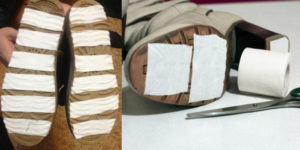 If there is a pharmacy nearby, you are very lucky.An ordinary medical plaster on a fabric basis, which is sold in rolls, like adhesive tape, can save you from falling on a slippery path. To do this, glue two pieces of plaster crosswise in the center of the sole.. If you do not want the patch to be visible when you raise your legs, then color it over with a black or brown felt-tip pen.
If there is a pharmacy nearby, you are very lucky.An ordinary medical plaster on a fabric basis, which is sold in rolls, like adhesive tape, can save you from falling on a slippery path. To do this, glue two pieces of plaster crosswise in the center of the sole.. If you do not want the patch to be visible when you raise your legs, then color it over with a black or brown felt-tip pen.
This method has a big disadvantage: it doesn't last long. Pieces of the patch come off quickly enough, so you have to change them almost every day. It’s even worse if it comes off while walking. To extend the life of one “cross”, stick it only on a dry and smooth (or slightly rough) surface of the sole.
A piece of rubber
 You can buy a special rubberized lining in the store, but it can be very difficult to find. You can recreate it yourself. To do this, cut out several small pieces of rubber and stick them on your shoes using shoe glue.. Choose rubber that matches the color of the sole so that it does not catch the eye of passers-by when walking.
You can buy a special rubberized lining in the store, but it can be very difficult to find. You can recreate it yourself. To do this, cut out several small pieces of rubber and stick them on your shoes using shoe glue.. Choose rubber that matches the color of the sole so that it does not catch the eye of passers-by when walking.
Apply soldering iron
If you have this electric tool at home, you can try to fix slippery shoes with thick soles. For this Using a heated soldering iron, carefully draw any pattern or design. The deeper the grooves are, the more ribbed the surface will ultimately be, and the anti-slip effect will be much more expressive.
Be careful when working with a soldering iron. Don't make the soles of your shoes too thin. It should still protect against winter frosts.
Nylon tights
Every girl has nylon stockings or tights in her bins, which she will never wear again, because she put a puff on them. Then use them to to create spikes on your slippery shoes. For this:
 using a lighter, match or candle, very carefully burn the nylon;
using a lighter, match or candle, very carefully burn the nylon;- Direct the resulting droplets onto the sole. Place a few drops at one point to create small bumps that resemble small thorns.
- Don't worry, this method is completely harmless. It will not burn through your shoes and will not interfere with walking.
Anti-slip devices for children's boots
Little children are real fidgets. They lead an active lifestyle, so it is necessary to select reliable methods to protect them on winter days. It is important that their shoes remain as functional and comfortable. The main rule is that we should not save on the health of our children.
To protect children, consider one of the following methods:
 Buy boots with grooved or patterned soles right away so that there is no need for additional protective equipment. In such shoes the child will be most comfortable during children's games and fun on the street;
Buy boots with grooved or patterned soles right away so that there is no need for additional protective equipment. In such shoes the child will be most comfortable during children's games and fun on the street;- professional options such as anti-slip rubber pads, children's ice pads or elastic bands. They look beautiful, are firmly attached and do not fall off on their own during a walk;
- Of the methods that you can recreate at home yourself, you can use felt, flannel or sandpaper linings for children's shoes. They create the strongest grip on the ground and are more durable. It is unlikely that a well-adhesive pad will come off in the middle of a walk.
All other methods described in the article should not be used for children. They are not reliable enough and are not suitable for actively moving children.


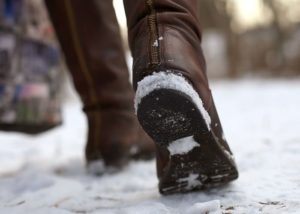 degrease the surface of the sole thoroughly (you can use alcohol or acetone);
degrease the surface of the sole thoroughly (you can use alcohol or acetone);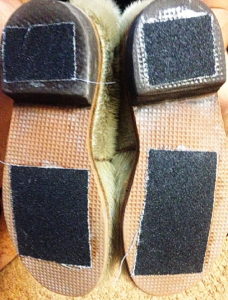 just rub the soles with coarse sandpaper to make the surface rough. However, this method will not last long; there is a high probability that the soles will become smooth again;
just rub the soles with coarse sandpaper to make the surface rough. However, this method will not last long; there is a high probability that the soles will become smooth again;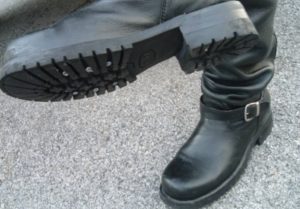 select screws that are slightly larger in size than the thickness of the sole;
select screws that are slightly larger in size than the thickness of the sole;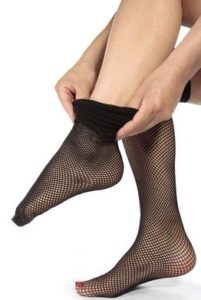 using a lighter, match or candle, very carefully burn the nylon;
using a lighter, match or candle, very carefully burn the nylon; Buy boots with grooved or patterned soles right away so that there is no need for additional protective equipment. In such shoes the child will be most comfortable during children's games and fun on the street;
Buy boots with grooved or patterned soles right away so that there is no need for additional protective equipment. In such shoes the child will be most comfortable during children's games and fun on the street; 0
0

